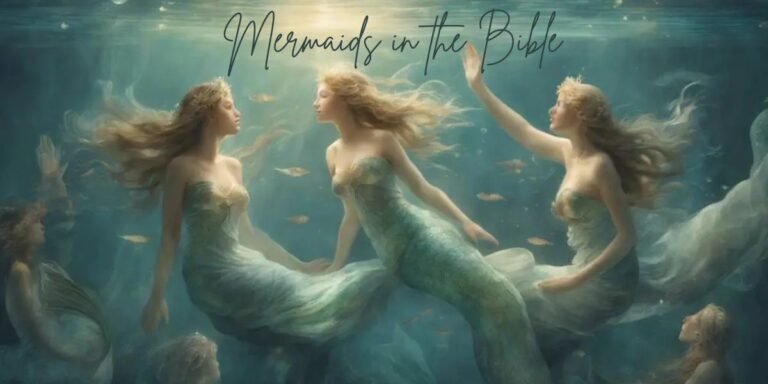Are There Mermaids in the Bible?
Mermaids have long been a part of folklore, myth, and popular culture. These half-human, half-fish beings are often depicted as enchanting creatures, swimming gracefully through the seas. However, the question of whether mermaids appear in the Bible is one that has intrigued scholars, theologians, and mythologists alike. Some wonder if mermaids were mentioned or represented in biblical texts, while others argue that such creatures belong strictly to mythology. In this article, we will delve into the concept of mermaids, explore their possible connections to the Bible, and investigate how these mythical beings relate to ancient cultures and religious symbolism.
Understanding the Origin of Mermaids
Mermaids, as we commonly know them, are a fusion of human and aquatic animal traits—usually a human torso with the tail of a fish. The origin of mermaid myths can be traced back to various ancient civilizations, including the Greeks, Assyrians, and Babylonians. In these cultures, mermaids were often associated with the sea and viewed as powerful and sometimes dangerous beings. However, the imagery of mermaids is not confined to Western traditions. In African, Asian, and European folklore, similar aquatic beings are found, each with their unique attributes and symbolism.
The idea of half-human, half-fish creatures appears in various mythological traditions, such as the Greek legend of the sirens, which are often conflated with mermaids, although sirens are typically depicted as bird-like creatures rather than fish-like. This cross-cultural phenomenon has led many to wonder whether mermaids, or similar beings, have any biblical roots or whether the Bible offers any references to such figures.
Mermaids in Ancient Cultures vs. the Bible
While the Bible contains a wide array of creatures, from angels to serpents, there is no explicit mention of mermaids as we imagine them today. The Bible does feature numerous references to water, sea creatures, and aquatic symbolism, which has led to some speculation about mermaids’ connection to biblical texts. However, mermaids, as half-human, half-fish entities, are not directly described in the scriptures. Let’s explore some relevant biblical elements that have sparked discussions about mermaids.
Water and Sea Creatures in the Bible
Water holds significant symbolism in the Bible, often representing chaos, destruction, and divine intervention. The story of Noah’s Ark, for example, portrays the floodwaters as a means of God’s judgment on a sinful world. Sea creatures are mentioned frequently in the Bible, most notably in the Book of Genesis, where God creates the waters and fills them with life. Creatures like Leviathan, a giant sea serpent, and the great fish that swallows the prophet Jonah are also prominent.
Leviathan, in particular, has been the subject of much debate. Some interpretations describe this creature as a massive sea beast that could symbolize evil, chaos, or even Satan. The imagery surrounding Leviathan shares some similarities with the idea of a powerful sea creature—similar to the folklore surrounding mermaids, who are often seen as mysterious, alluring, and dangerous.
The Book of Jonah and Aquatic Mythology
The most direct mention of sea creatures in the Bible is found in the Book of Jonah, where Jonah is swallowed by a “great fish” (often translated as whale). While this creature is not specifically described as a mermaid, it shares some features with aquatic mythological beings, such as its connection to the sea and its role in Jonah’s story of redemption. The fish (or whale) serves as an instrument of God’s will, transporting Jonah to the shore and signaling his return to obedience.
Though the creature in Jonah’s story is not described as a mermaid, some readers and scholars have drawn comparisons between the mythological concept of a sea monster and biblical depictions of great sea creatures. These comparisons often highlight the symbolic role that water and sea creatures play in biblical narratives.
Symbolism of the Sea and Creation
In biblical texts, the sea often represents something beyond mere physical water. It symbolizes chaos and mystery but also the power and authority of God over all creation. In the opening chapters of Genesis, for example, God separates the waters to create the world. In other places, the sea is a metaphor for spiritual or emotional turmoil. Many interpretations of mermaid myths focus on the idea that these creatures are embodiments of the unknown—both alluring and dangerous, much like the sea itself in the biblical sense.
For mermaids to be considered in the context of the Bible, one must look at the broader theological and symbolic use of water. While the Bible does not specifically mention mermaids, the underlying themes of the sea, creatures of the deep, and the mysterious nature of water offer a fertile ground for metaphorical connections.
Mythological Connections to Biblical Themes
Though mermaids themselves are not explicitly mentioned in the Bible, there are mythological creatures and figures that have parallels with the traits associated with mermaids. In addition to the Leviathan, other mythological references exist in ancient texts that may share similarities with mermaid mythology.
The Sirens: A Connection to Biblical Temptation
One of the closest mythological figures to the mermaid is the siren. In Greek mythology, sirens are often depicted as beautiful, seductive beings who lure sailors to their doom with their enchanting songs. These creatures were said to sing songs that tempted sailors to steer their ships into dangerous waters, where they would be wrecked on the rocks.
The concept of temptation is prevalent throughout the Bible, especially in the stories of Adam and Eve, the temptation of Christ, and the imagery surrounding sin and moral corruption. While sirens are not directly mentioned in biblical texts, their role in mythology echoes the biblical theme of temptation, deceit, and the danger of being drawn into sin by something seemingly beautiful or alluring.
The Sea as a Biblical Symbol of Temptation
In addition to the metaphor of chaos and destruction, the sea often symbolizes temptation and the unknown in the Bible, in the story of Peter walking on water. He begins to sink when his faith falters and he becomes distracted by the wind and waves (Matthew 14:30). In this sense, the sea represents both divine power and the temptation to doubt God’s authority.
This metaphorical connection to the sea could be linked to the image of mermaids in that both embody the dual nature of beauty and danger. Just as the sea can both nurture life and swallow it whole, mermaids, in folklore, are often portrayed as creatures that can either offer enchantment or pose a threat.
The Absence of Mermaids in the Bible: Why?
Given the rich symbolism and mythological creatures present in the Bible, why is there no mention of mermaids as we understand them? Several theories can explain this absence:
Focus on Real Creatures
The Bible tends to focus on animals and creatures that were real or at least familiar to the ancient peoples who composed the texts. Mermaids, as creatures of myth, may not have been a part of the ancient Jewish. Or Christian imagination in the same way that other symbolic creatures like lions, serpents, or birds were. Ancient cultures were more likely to focus on real animals or fantastical beings that had tangible relevance to their environment.
Different Cultural Influences
Mermaids, as we know them, emerged from a blend of Mediterranean and Near Eastern mythology. With roots in ancient Assyrian, Greek, and even African and Asian traditions. These cultures often had distinct mythologies that didn’t necessarily align with the biblical worldview. The Hebrew Bible, written in a different historical and cultural context, would not have included these creatures in its religious texts.
Theological Implications
From a theological perspective, the Bible’s message is focused on God’s creation, salvation, and human morality. Creatures like mermaids—often associated with temptation, seduction, and chaos in folklore. Might not fit well within the narrative that emphasizes divine order and human responsibility. Including mermaids could have detracted from the biblical emphasis on the human relationship with God.
Conclusion
While there is no direct mention of mermaids in the Bible, the themes of water, temptation, and the creatures of the deep are woven throughout the scripture, providing a rich backdrop for the symbolic interpretations of sea creatures like mermaids. The absence of mermaids in biblical texts does not diminish their cultural significance or their role in mythological traditions. In fact. The connection between sea creatures, divine power, and human temptation remains a prominent theme in both the Bible and in the folklore surrounding mermaids.
Ultimately, the concept of mermaids in the Bible is a blend of myth, metaphor, and theological reflection. Whether viewed as symbols of beauty and danger, or as representations of human temptation. The creatures of the sea continue to captivate our imaginations, even if they are not explicitly mentioned in the scriptures.
FAQs
Why don’t mermaids appear in the Bible?
Mermaids are not mentioned in the Bible because they are creatures of myth and folklore. The Bible focuses on real animals and the symbolism of sea creatures that are more relevant to the cultural and theological context of the time.
Are there any biblical creatures similar to mermaids?
While there is no direct mention of mermaids, creatures like Leviathan and the “great fish” in the Book of Jonah share some similarities with mermaid mythology in terms of their connection to the sea and their symbolic roles.
Do mermaids represent temptation in the Bible?
Though mermaids are not mentioned in the Bible, mythological creatures like sirens. Who represent temptation—can be seen as analogous to the biblical theme of being led astray by seductive forces.
What role do sea creatures play in the Bible?
Sea creatures in the Bible often symbolize chaos, divine power, and spiritual meaning. They are associated with God’s authority over creation and are mentioned in stories like Noah’s Ark. Jonah’s encounter with the great fish, and the chaos of the sea.
Can mermaids be considered symbols of beauty and danger in biblical terms?
Yes, mermaids, in mythological traditions, can be seen as symbols of both beauty and danger. Which parallels the biblical themes of temptation and the dual nature of the sea—nurturing yet perilous.

